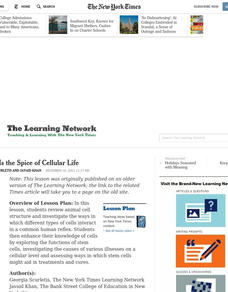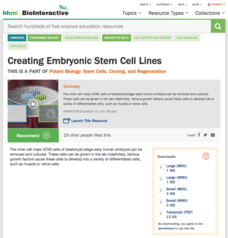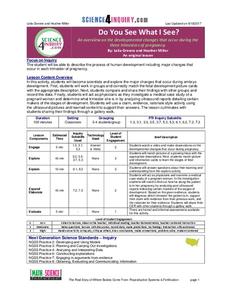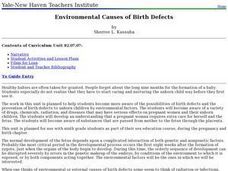Embryo Teacher Resources
Find Embryo lesson plans and worksheets
Showing 83 resources
Curated OER
Human Embryo Development and Birth Defects
Open this lesson with a discussion on birth defects. Break the class into groups to visit a website and learn about what happens at each stage of human embryo and fetal development. Assign each group a particular birth defect to...
Deep Look
In the Race for Life, Which Human Embryos Make It?
Computers help doctors determine the most viable embryos. Researchers discovered the rate of embryo growth has a direct link to its sustainability. Pupils discover how doctors apply this research to help their patients.
Howard Hughes Medical Institute
Development of the Human Embryonic Brain
Viewers follow the development of a human embryo, the brain, and the number of neurons at each stage. They learn when the brain stops growing and the importance of neural connectivity.
Curated OER
Human Development
Three-dimensional animation zooms in on human development as it begins in the female ovaries. The animated egg changes and forms as you watch it travel down the fallopian tube into the uterus.
Howard Hughes Medical Institute
Human Embryonic Development
At what point in the fertilization process do stem cells turn into an embryo? Viewers observe the development of an embryo from egg to fertilization to development into a fetus. The narrator stresses the role of cell division,...
Curated OER
Human Cloning: Is it Biological Plagiarism?
Is cloning good or harmful? Help your class understand the risks and benefits as they read, research, and discuss human cloning. Individuals form teams, research information, and present to the class before concluding with an in-depth...
Curated OER
Human Reproduction: Fertilization and Fetal Development
The journey of a fertilized egg is illustrated as it travels from the fallopian tube to the uterus. Cell division is explained and the miracle of life is shown.
Curated OER
Variety Is the Spice of Cellular Life
Do you need to review animal cell structure? Investigate the ways in which different types of cells interact in a common human reflex. Your students can explore the functions of stem cells, consider various illnesses and assess stem...
Curated OER
Human Embryology
Ninth graders are introduced to the concept of human embryology. Individually, they complete an exercise in which they determine which trait they got from which family member. In groups, they identify and label the reproductive organs...
Howard Hughes Medical Institute
Creating Embryonic Stem Cell Lines
Even today's stem cells have a history—and it's more than 30 years old! Learn how stem cell lines grow in a lab. Observe the various experiments completed to determine how cells grow in human embryos.
Kenan Fellows
Detecting Rise in Body Temperature in Human and Animals and its Effects on Health
Beat the heat using sensors. Scholars research normal body temperatures for humans and a specific animal. In groups, they create sensors that monitor body temperature, as well as the weather. The goal is to reduce the occurrence of heat...
Curated OER
Life Cycle- The Human Body
Seventh graders examine the life cycle of the human. In this human life cycle lesson, 7th graders discuss the many different stages of the human life cycle. Students use pictures from magazines to create a representation of the human...
Curated OER
Comparison of Normal vs Mutant Zebra Fish Embryos
Young scholars observe and study mutations. In this mutations lesson plan, students work in groups to complete observation tables of various mutations of the zebra fish embryos. Groups give presentations about their observations.
Science 4 Inquiry
Do You See What I See?
In only nine months, a small group of cells grows into a fully developed baby. Pupils learn about the development of an embryo to a fetus to a baby. They identify each step of weekly development. Young scientists look at ultrasounds to...
Curated OER
Embryo Development
High schoolers observe the development of a chicken embryo. In this biology lesson, students compare and contrast the development of human and chick embryo. They make a chart and explain their findings to the class.
Be Smart
Where Do Teeth Come From?
Surprisingly, dinosaur teeth and human teeth have a lot in common. Scholars discover how teeth form during embryonic development. They then compare fossil evidence of the similarities of teeth of ancient species.
Curated OER
The Effects of "Recreational" Drugs on the Development of Chick Embryos as a Model for Human Embryogenesis
Students conduct experiments on fertilized chicken embryos to determine the possible developmental effects that various recreational drugs (caffeine, alcohol, nicotine, and aspirin) might have on them.
Curated OER
Human Embryonic Stem Cells
Students use the Internet to discover information about human embryonic stem cells from the National Institutes of Health. They examine different sides of the debate to use or not to use stem cells. They can also listen to speeches given...
Curated OER
Environmental Causes of Birth Defects
Get your high schoolers thinking about the factors that lead to birth defects. They examine how environmental factors and personal choices can cause birth defects in unborn children. They discover the effects of various handicaps such as...
Be Smart
Could We Clone Ourselves?
All naval oranges are clones and come from a single tree in Brazil. Viewers see how the human genome can be manipulated in a video that also discusses cloned produce, cloned animals, identical twins, and wraps up by talking about humans...
Crash Course
Animal Development: We're Just Tubes
All humans begin as one cell and through mitosis, develop into an organism made of millions of cells, each specialized to keep people alive. The narrator of this short video explains the process by which embryos grow from a morula to a...
Curated OER
Biotechnology
A continuous cascade of information comes through this PowerPoint on biotechnology. The topic is defined, a history is presented, and basic genetic engineering techniques are explained. The topic is covered in an objective manner,...
Curated OER
Pregnancy, Day 1: The Developing Baby
Twenty-six pages of good information about pregnancy. Pictures and descriptions describe the moment the sperm and egg unite, and there are worksheets that learners can complete. This is a pretty comprehensive lesson plan for one day. It...
Curated OER
Heredity, Genetics, Traits
Eighth graders study how an embryo develops into a fetus by undergoing many physical changes which they observe on a poster. They examine the metamorphosis of fruit flies as they develop through a series of changes. They record the...

























